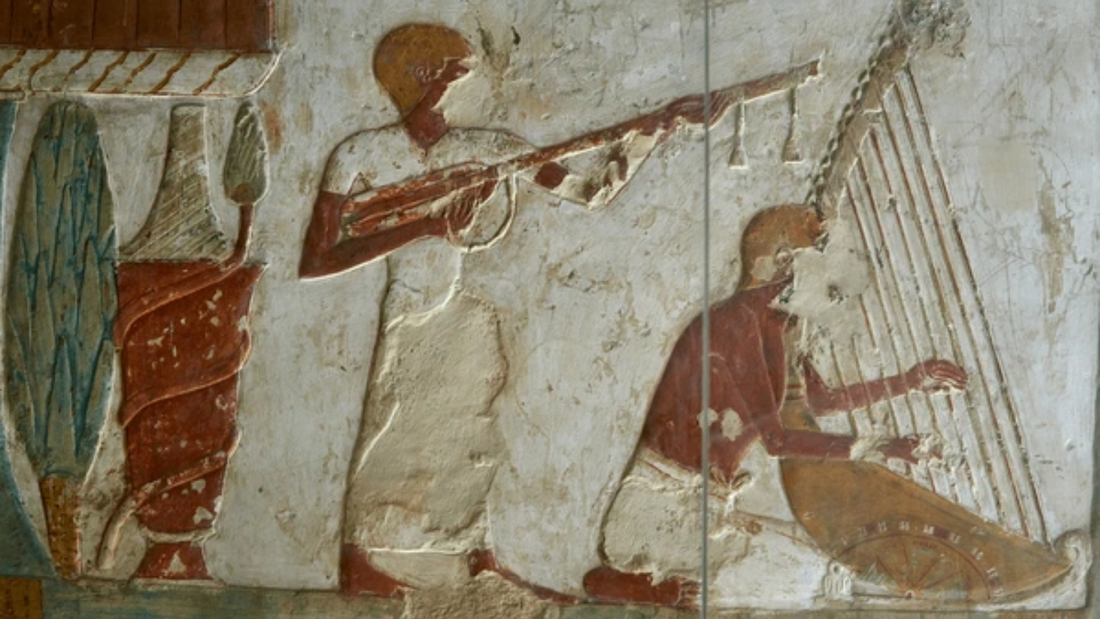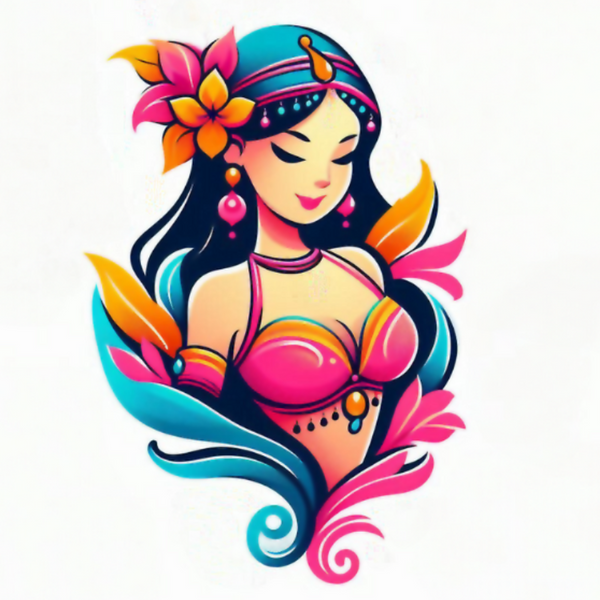
Share
The Evolution of Music in Egypt
Music in Egypt has a long and complex history that reflects a mosaic of cultural, social, and technological changes over millennia. From its ancient roots to present day, Egyptian music continues to be a dynamic force, influencing and adapting to trends locally and globally.

Ancient Egyptian Music
Archaeological findings reveal that ancient Egyptians used a range of instruments like the sistrum (a rattle used in religious ceremonies), the lyre, the nefer (a type of flute) and drums. As seen in the tomb of Nebamun, music and dance played an important role in religious rituals and celebrations.

Coptic Hymns
The hymns sung in Coptic, a language that evolved from ancient Egyptian still used in religious services, has its roots in early Christian liturgy. The chanted hymns were performed with instruments like cymbals (both hand-held and larger sizes) and the triangle.

The tradition of Coptic chant, which is deeply rooted in early Christian practices, may have connections to ancient liturgies from Jerusalem or Syria. However, the earliest surviving manuscripts date from more recent times, since much of the earlier tradition was passed down orally.

Muwashshah
With the advent of Islam, music in Egypt experienced notable changes. The oud, a pear-shaped lute with a rich, resonant sound, and the darbuka, a goblet-shaped drum, became prominent in the music scene. During the 9th to 13th centuries, a musical form called Muwashshah emerged from Al Andalus, Spain.

The style involves setting poetry to music using complex structures with stanzas, which are short lyrical lines called kharja, where local dialects were used and the main body of the poem, called Muwashshahat was written in classical Arabic.

The blend of languages and intricate patterns introduced elaborate rhythmic and melodic elements to the music. The development of maqamat, musical modes or scales used in Middle Eastern music, provided a framework for creating melodies and rhythms, laying the groundwork for many musical structures still used today.

Folk Music
Egyptian folk music incorporates instruments like the oud, qanun, and darbuka, that reflect the rhythms and melodies of Egyptians' daily lives. Using the violin and accordion, Sayed Darwish (1892- 1923) integrated innovative melodies and rhythms modernizing traditional folk music.

His work, including songs like "El-Sabahiya" introduced new approaches while staying true to the traditional sounds. Darwish's influence extended to composing Egypt's national anthem, "Bilady, Bilady, Bilady," showcasing his impact on both Egyptian music and national identity.

Early 20th Century Innovations
The early 20th century saw a shift in Egyptian music. Mohamed Abdel Wahab (1907-1991) was a key figure in blending Arabic music with Western orchestral rhythm. Compositions like "Ya Jarat Al Wadi" showcased his creative approach by combining instruments like the trumpet and and clarinet with the oud and darbuka.

Wahab’s orchestral arrangements expanded the possibilities of music, bridging the gap between Eastern and Western music. His contributions helped shape the development of modern Egyptian music and its performance styles.

Umm Kulthum’s Legacy
Umm Kulthum (1904-1975) became an iconic figure in Arabic music. Her powerful voice and intricate compositions, including hits like "Alf Leila We Leila" and "Enta Omri", have made a lasting impact.

Her music often included orchestral arrangements that featured a mix of strings, brass, and woodwinds, complementing traditional instruments like the oud and qanun. Kulthum's music, with its complex rhythms and emotive melodies, continues to resonate through the streets of Egypt.

Impact of Egyptian Cinema
During the mid-20th century, Egyptian cinema played a crucial role in popularizing Egyptian music. Films frequently featured elaborate musical numbers and dance sequences.

Composers like Farid al-Atrash (1915-1974), known for his fusion of classical Arabic music with modern orchestration, used instruments like the violin, oud, and accordion in compositions like "Ya Zahratan Fi Khayali,".

Arabic Chanson
Introducing new orchestral textures, Arabic Chanson combines Arabic music with Western chanson, a French musical style known for its focus on lyrical and emotional storytelling. It features a blend of Western orchestral instruments, like strings and brass, with the oud and qanun.

Key figures in Arabic Chanson include Abdel Halim Hafez and Warda Al-Jazairia. Known for his emotional depth, Hafez’s "Ahwak" skillfully combines Western orchestration with traditional Arabic melodies, creating a rich and innovative sound., while Warda’s "Batwanis Beek" showcases her ability to blend classical Arabic music with modern arrangements.

Shaabi Music
By the 1980s, Shaabi music emerged as a dominant genre in Egypt. known for its energetic rhythms and often provocative lyrics, Shaabi became the soundtrack of urban life.

Artists like Ahmed Adaweyah contributed to integrating folk elements and modern sounds with songs like "Balash El Loun Da Maana". Hakim gained fame by incorporating electronic keyboards and drum machines into their music with an innovative use of traditional rhythms. His hit "El Biehsal Da" is a great example of Shaabi's appeal.

Egyptian Pop
A new era of pop music emerged, led by artists like Mostafa Amar and Amr Diab. Mostafa Amar, known for hits like "Layaliki" and "Al Sood Oyouno" combined romantic ballads with electric guitars and drum machines.

Amr Diab revolutionized the genre with his album "Nour El Ain", blending Arabic music with synthesizers and electronic beats to achieve global recognition.

Mahraganat
The fast-paced rhythms and electronic influences of Mahraganat have shaped the soundscape of modern Egyptian music. Mahragan music emerged as a genre that fuses Arabic rhythms with electronic beats incorporating digital synthesizers and auto-tuning, with artists like El Sawareekh and Mohamed Ramadan.

El Sawareekh's use of electronic music, as shown in their song "Ekhwaty", and Mohamed Ramadan's "Thabet", highlight the genre's broad reach. The music reflects the vibrancy of Egyptian culture today.

Digital Revolution
The digital era has transformed how Egyptian music is produced and distributed. Platforms like YouTube, Spotify, and Soundcloud allow artists to reach a global audience where they can experiment with new musical styles. Digital tools have also enabled the preservation of traditional music, allowing it to coexist with modern innovations.

International Influence
Egyptian music continues to impact and be influenced by international trends. The ability to integrate global sounds while maintaining its traditional roots underscores its ongoing relevance. As Egyptian music evolves, it remains a vibrant part of both Egyptian culture and the global music scene.

Echoes of Evolution
From ancient roots to modern innovations, Egyptian music showcases a dynamic interplay of tradition and modernity, continuing to be an influential part of the Egyptian culture.

